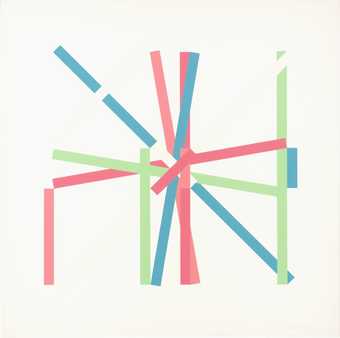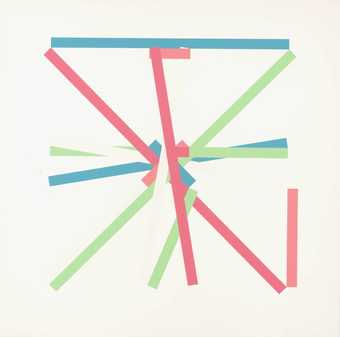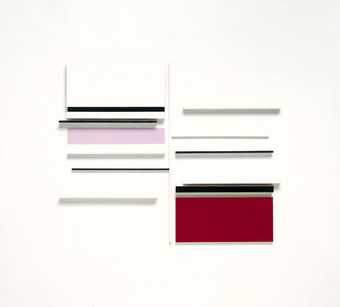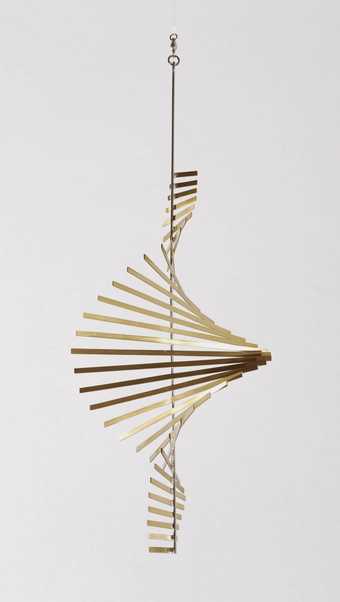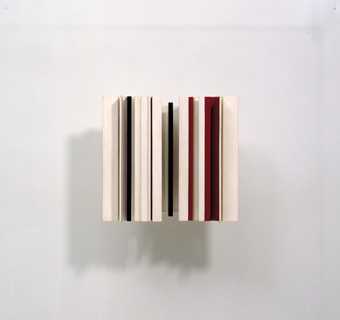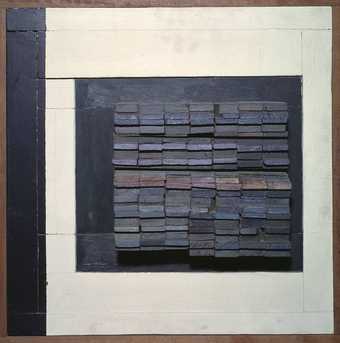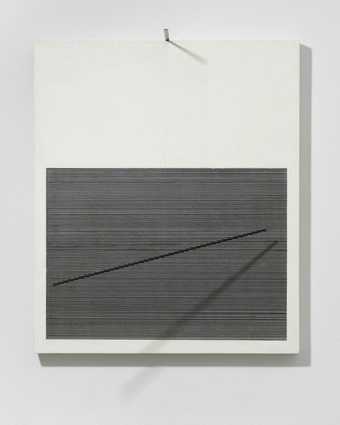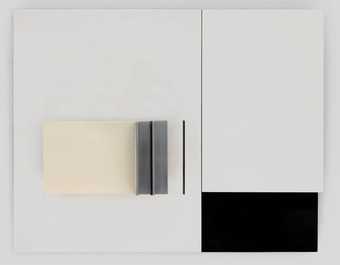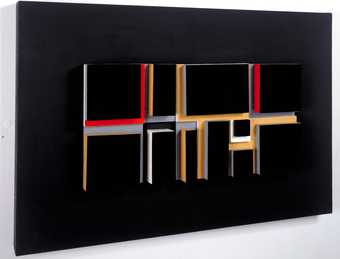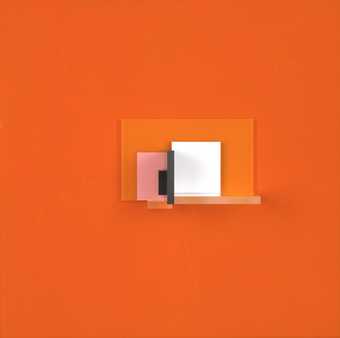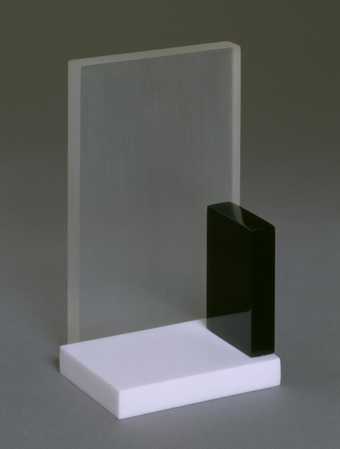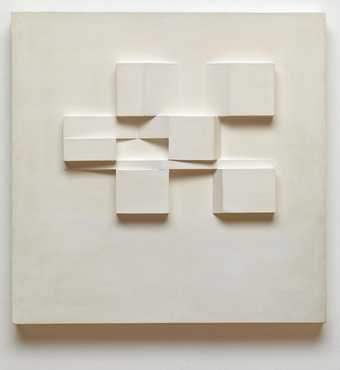
In Tate Modern
- Artist
- Mary Martin 1907–1969
- Medium
- Painted chipboard
- Dimensions
- Object: 457 × 457 × 95 mm
- Collection
- Tate
- Acquisition
- Purchased 1963
- Reference
- T00586
Display caption
Martin said that abstract painting had led to a desire to use three-dimensional materials. This work follows a strict mathematical rule, the Golden Section. It dictates the size of different elements, with the aim of creating the perfect composition. Writing about this work, Martin explained, 'I took a simple element (in this case a parallelepiped – a solid figure whose faces are six parallelograms) and subjected it to a system of changes, not knowing what would happen to it…. I think all my work has been based on this kind of curiosity.'
Gallery label, August 2020
Does this text contain inaccurate information or language that you feel we should improve or change? We would like to hear from you.
Catalogue entry
T00586
Painted ‘weyroc’ chipboard, 457 x 457 x 96 mm (18 x 18 x 3 ¾ in)
Inscribed by the artist on back in black paint ‘Mary Martin’ top left, ‘MARY MARTIN | 9 ETON AVENUE | NW3 | “Spiral Movement” | 1951’ bottom centre; label inscribed ‘C 28233/3’ top right
Purchased from the artist (Grant-in Aid) 1963
Exhibited:
London Group, New Burlington Galleries, London, October-November 1952 (138, as ‘Relief’)
Dimensions: British Abstract Art 1948-57, O’Hana Gallery, London, December 1957 (45)
Konkrete Kunst, Helmhaus, Zurich, June-August 1960 (85, reproduced)
Mary Martin Kenneth Martin, Arts Council tour, Museum of Modern Art, Oxford, May 1970, Towner Art Gallery, Eastbourne, June-July, Royal Albert Memorial Museum, Exeter, July-August, Leeds City Art Gallery, August-September, Wolverhampton Municipal Art Gallery and Museum, September-October, Faculty of Art & Design, Manchester Polytechnic, October, Mappin Art Gallery, Sheffield, November, Ferens Art Gallery, Kingston-upon-Hull, December 1970 - January 1971, Norwich Castle Museum, January, Scottish Arts Council Gallery, Edinburgh, February, Welsh Arts Council Gallery, Cardiff, March, Bristol City Art Gallery, April 1971 (not in catalogue)
Henry Moore to Gilbert and George: Modern British Art from the Tate Gallery, Palais des Beaux Arts, Brussels, September-November 1973, as part of Europalia 73 Great Britain (70)
Mary Martin, Tate Gallery, London, October-November 1984 (2, reproduced p.13)
Forty Years of Modern Art, Tate Gallery, London, February-April 1986 (no number)
Home and Away, Tate Gallery Liverpool, November 1995 - April 1997 (no number)
Literature:
Tate Gallery Report 1963-4, London 1964, pp.33-4
Mary Chamot, Dennis Farr and Martin Butlin, Tate Gallery: The Modern British Paintings, Drawings and Sculpture, II, London 1965, pp.428-9
Alastair Grieve, ‘Charles Biederman and the English Constructionists 2: An Exchange of Theories about Abstract Art during the 1950s’, Burlington Magazine, vol.126, no.971, February 1984, p.68
Penny Jones, ‘Aspects of the Relationship between Mathematics and the British Constructionists, c.1948-60’, unpublished MA report, Courtauld Institute of Art, University of London, 1988, pp.23-4, pl.11
Penelope Curtis, Modern British Sculpture from the Collection, Tate Gallery Liverpool 1988, p.97, reproduced
Un Siècle de Sculpture Anglaise, exhibition catalogue, Jeu de Paume, Paris 1996, p.470, reproduced
Margaret Garlake, New Art, New World: British Art in Postwar Society, London and New Haven 1998, p.115
Reproduced:
Lawrence Alloway, Nine Abstract Artists, London 1954, p.41
Alan Bowness, ‘The Constructive Art of Mary Martin, Studio International, vol.175, no.898, March 1968, p.120
Adrian Lewis, ‘British Avant Garde Painting 1945-56, part II’, Artscribe, no.35, June 1982, p.30
Spiral Movement is one of Mary Martin’s earliest reliefs. It consists of squares and wedges - which she called ‘tilts’ - cut from chipboard and glued within a 3 x 3 grid on a base board of the same material. The whole was attached to a larger backing board with butt-jointed battens on the reverse; at the corners, the heads of the pairs of screws used to fix the board have become visible. All surfaces were thickly painted with two coats of emulsion, with the upper coat being slightly greyer in tone. The selection of the materials and their assembly betray an experimental stage of development, as wood or plywood were preferred for later works to brittle chipboard. Martin herself acknowledged: ‘There are technical problems, certainly. I knew nothing about carpentry and all the cutting and shaping had to be done by hand with a saw and sandpaper’.[1]
It is characteristic of Martin’s reliefs that the composition should be determined by a complex layering of geometrical relationships. This is true of all of the elements of Spiral Movement. Thus, the base board measures 9 x 9 x 15/16 inches (228 x 228 x 23 mm), its sides being very nearly equivalent to the diagonal of the relief grid - a relationship which follows root-two geometry. The relief area itself occupies a square with 6 inch (152 mm) sides and follows a chess board pattern of five (negative) voids and four (positive) volumes, each constituent square measuring 2 x 2 x 15/16 inches (52 x 52 x 23 mm). Within this grid, subdivisions were made along the Golden Section division in five squares: the upper left, middle right and all of the lower squares. Each of the resulting Golden Section rectangles is filled with a tilt. The treatment of the central void and the four adjacent positive volumes (in the middle of each side) is symmetrical about the diagonal from bottom right to top left. The bottom right square also comes close to complying with this symmetry, as the two tilts there leave a square void in the extreme corner. This establishes a progression of squares, increasing in size and moving up the diagonal, which forms a spine for the composition: from the small corner square (the reciprocal of the Golden Section), through an implied square set up by the two tilts (the Golden Section), to the central void. Against this symmetry, a rotation is implied by the introduction of the longer tilts in the left column (top and bottom left).
Spiral Movement was acquired a dozen years after its completion and Martin’s recollection of the circumstances were published shortly after.[2] She wrote:
The most interesting thing about the work ... is that it is the first relief which I ever constructed. Abstract painting gave me a desire to use three-dimensional materials and this first essay was based on the same concept I had used in painting. That is to say that I took a simple element (in this case a parallelepiped) and subjected it to a system of changes, not knowing what would happen to it, and without any knowledge of the final appearance of the work. I think all my work has been based on this kind of curiosity.[3]
As well as acknowledging the introduction of chance as a balance to the rationality of geometry, this provides a significant glimpse of Martin’s methods. It suggests that an assembly of physical parts had followed the preliminary application the ‘system of changes’ to one or possibly a sequence of parallelepipeds, in diagrammatic or solid form. A parallelepiped has six faces arranged in parallel pairs; the perfect example of such a solid is a cube. Approximate half-cubes provide positive volumes in the relief (top centre and middle left) and the adjacent tilts can be considered as half parallelepipeds. Taken together, all the elements may result from the cutting up of a single large parallelepiped. Alternatively, the ‘system of changes’ may have been applied to individual elements within the grid, each divided, cut or shifted in turn, a sequential scheme which would comply with the artist’s subsequent practice.
Martin’s letter also made clear that Spiral Movement embodied a pivotal moment in her career between two dimensional work and her concentration upon constructed reliefs. This shift involved the transfer of systems devised in plan to those being developed in three dimensions. Referring elsewhere to her use of the tilt, Martin clarified this relationship:
my use of it goes back to the first relief I made. This was a straight translation of preceding paintings, which I had constructed by movement of a format through positive and negative areas (chess board). The positive areas were painted white and the negative areas black but those areas which partook of both positive and negative were painted earth red. Grey, the logical colour, was illusionistic and dead, but red, its opposite, lived up to the black and white.[4]
In this way the tilts became the three-dimensional equivalent to the red transitional areas of the paintings. The ‘first relief’ referred to here was the carved plaster Columbarium, 1951 (artist’s estate),[5] which immediately preceded Spiral Movement, but the coding of the parts by the colouring of the paintings provides an important insight into Martin’s working development.
Following this coding it is possible to recognise that the composition of Spiral Movement derived from Square Form, exhibited in Abstract Painting, Sculptures, Mobiles at the Artists International Association in May-June 1951.[6] This was amongst the last of Martin’s exhibited paintings, as Columbarium appeared in the London Group exhibition five months later (November 1951) and Spiral Movement in the equivalent exhibition in the following year. The relationship between the painting and the relief is clear, as Square Form
(though rectangular rather than square) was also divided into a grid of nine units. Its subdivisions in the extreme corners were white, while the top centre and middle left areas were black; both correspond in general terms to the voids and the cubes of Spiral Movement. The remaining red areas correspond generally to the subsequent tilts.
The plan of Spiral Movement has been the point of departure for other analyses. Michael Compton has noted: ‘The secondary lines are used to generate a series of six golden section rectangles arranged in a spiral - the last two are easy to see in the left and top registers. Where a rectangle overlaps a square (as it always does) it becomes a tilt’.[7] The six rectangles alluded to are made up of a square and the Golden Section rectangle of its neighbour. This was explored by the artist’s son Paul Martin: ‘The system of rectangles starts at the centre then moves in a clockwise direction outwards by 90º turns making a spiral movement. The rectangles are either incised out of or added to the half-cubes by tilted volumes ... In “Spiral Movement” the tilts follow the direction of the spiral and activate the surface’.[8] The accompanying diagram actually begins the spiral from the tilt in the bottom centre, but identifies the six square + tilt rectangles as overlapping in the centre and opening out in the course of the spiral.
Such an approach exemplifies the overlaid geometry of Martin’s reliefs. In a summary account of her career, she shed further light upon her method by stating: ‘The first constructed reliefs I made were based upon the moving format of Cubism combined with a system of positive and negative spaces (1951-4)’.[9] The ‘moving format’ was a geometrical device identified by J.W. Power in his 1933 book Elements of Pictorial Construction,[10] which Martin and other Constructionists (such as Victor Pasmore) consulted. It described the movement of a unit, such as a rectangle, across a plane by sliding and rotating, with each stage determining the location of related elements within a composition. By adapting rotations from Power’s ‘moving format’ to the sequence suggested by Paul Martin’s analysis of Spiral Movement it is possible to develop a spiral from the centre using the same unit. Such a scheme could be described thus: rectangle middle centre + bottom centre tilt (1) rotates 90º anticlockwise about the centre point to (2) middle centre + middle right tilt, slides down to (3) bottom centre + bottom right tilt, rotates 90º anticlockwise and slides to (4) middle left + bottom left tilt, rotates 90º anticlockwise and slides to (5) top centre and top left tilt.
This analysis traces a waltzing motion of anticlockwise turns describing a larger clockwise spiral. However, it encounters certain difficulties: it overrides the important interplay of positive and negative volumes, and it fails to determine the important reciprocal square in the extreme bottom right corner. Furthermore, it is not easily reconciled with the artist’s specific account of the genesis of Spiral Movement in the manipulation of a three dimensional solid (the parallelepiped). With these inadequacies as evidence of the conceptual layering of an apparently simple work, it may be that the original composition was determined by the symmetry about the rising diagonal, and that the spiralling movement generated by the asymmetrical tilts emerged during the process of making. Such an evolving method would be consistent with the experimental nature of Spiral Movement as Martin’s first constructed relief. In this connection, it is notable that the present title was not the original, and that the work was first exhibited simply as Relief; of this the artist remarked that the fact ‘that I had once exhibited it as “Relief” ... is a comment on that particular time’.[11] Nevertheless, the recognition of the spiral reflected emerging concerns and the flexibility of the format is even suggested by the plywood relief, also called Spiral Movement, 1954 (Arts Council),[12] which was based upon a modification of the Tate work.
Like Power’s analysis of the ‘moving format’, organic developments such as the spiral were important to the work of Martin and other Constructionists around 1950-1. They were informed by scientific findings such as those brought together in D’Arcy Thompson’s On Growth and Form (Cambridge 1917 and 1942) which formed the basis of the exhibition Growth and Form organised in the summer of 1951 at the Institute of Contemporary Art by Richard Hamilton. The serial developments described by Thompson were adapted by the Constructionists as an alternative link to nature from pictorial realism; Martin would topically describe her resulting works as ‘nuclear building’ because of their cellular development.[13] Such spiral forms were also the basis, in rather different terms, of Kenneth Martin’s mobiles, such as the Small Screw Mobile (Tate T00552).
If the formal progression within such works as Spiral Movement was related to organic sciences, Martin’s use of the technique of relief had particular resonances to European modernism. The exclusion of colour recalled Ben Nicholson’s White Reliefs of the 1930s, as Lawrence Alloway remarked in 1954,[14] even if Martin’s definition of volume differed from his shallow planes. Nicholson was in direct contact with Pasmore and Adrian Heath by 1949, and he showed works with the Constructionists in 1951 (in Abstract Paintings, Sculptures, Mobiles, Artists International Association) and at the exhibitions held in Heath’s 22 Fitzroy Street studio in 1952-3. He also provided a link to Mondrian, whose formally and colouristically reductive painting was considered by the Constructionists as the pivotal example of a constructive modernism.
The younger artists’ enthusiasm for Mondrian was also shared by the American Charles Biederman. His idiosyncratic survey of the history of art, Art as the Evolution of Visual Knowledge,[15] proved influential both through its argument and its illustrations of his own reliefs, and those of European artists such as Jean Gorin and Cesar Domela. The depth and rectilinearity of Martin’s reliefs - and those of Pasmore and Anthony Hill - reflect a debt to these sources. Although, as Grieve has shown,[16] Biederman differed from the Constructionists in many fundamentals, his conviction that the relief was the next logical step from the position attained by Mondrian was shared by Mary Martin in particular. By the end of the 1950s this would find resonances elsewhere, as Spiral Movement was chosen by the Zurich Constructivist Max Bill to appear alongside works by Arp and Georges Vantongerloo in the Konkrete Kunst
exhibition.[17]
Matthew Gale
October 1997
[1] Mary Martin, letter to Tate, 21 May 1963, Tate catalogue files.
[2] Mary Chamot, Dennis Farr and Martin Butlin, Tate Gallery: The Modern British Paintings, Drawings and Sculpture, vol.II, London 1965, pp.428-9.
[3] Letter, 21 May 1963.
[4] Martin, ‘Statement’, December 1967, in Alan Bowness, ‘The Constructive Art of Mary Martin, Studio International, vol.175, no.898, March 1968, p.121, also quoted in Mary Martin, exhibition catalogue, Tate Gallery, London 1984, p.14.
[5] Reproduced ibid., p.11, no.1.
[6] See installation photograph in Alastair Grieve ‘Towards an Art of Environment: Exhibitions and Publications by a Group of Avant-Garde Abstract Artists in London 1951-55, Burlington Magazine, vol.132, no.1052, November 1990, p.775, fig.14.
[7] Michael Compton, in Tate Gallery exhibition catalogue, 1984, p.15.
[8] Paul Martin, ibid. p.35.
[9] Martin, ‘Statement’, in Bowness 1968, p.121.
[10] J.W. Power, Elements of Pictorial Construction, Paris 1933.
[11] Martin, letter, 13 February1964, Tate catalogue files.
[12] Reproduced in Tate Gallery exhibition catalogue, 1984, p.14, no.7.
[13] Martin quoted by Paul Overy, Mary Martin Kenneth Martin, exhibition catalogue, Arts Council tour 1970, p.11.
[14] Lawrence Alloway, Nine Abstract Artists, London 1954, p.14.
[15] Charles Biederman, Art as the Evolution of Visual Knowledge, Red Wing, Minnesota 1948.
[16] Alastair Grieve, ‘Charles Biederman and the English Constructionists 2: An Exchange of Theories about Abstract Art during the 1950s’, Burlington Magazine, vol.126, no.971, February 1984.
[17] Konkrete Kunst, Helmhaus, Zurich, June-August 1960.
Explore
- abstraction(8,615)
-
- non-representational(6,161)
-
- geometric(3,072)
- formal qualities(12,454)
-
- movement(172)
You might like
-
Kenneth Martin Rotation ‘Frankfurt’ I
1977 -
Kenneth Martin Rotation ‘Frankfurt’ IV
1977 -
Victor Pasmore Abstract in White, Black, Indian and Lilac
1957 -
Kenneth Martin Small Screw Mobile
1953 -
Victor Pasmore Relief Construction in White, Black and Maroon
1962–3 -
Matt Rugg Painted Unit Relief
1963 -
Mary Martin Spiral
1963 -
Jesus Rafael Soto Horizontal Movement
1963 -
Mary Martin Inversions
1966 -
Anthony Hill Relief Construction
1963 -
Mary Martin Black Relief
1957–c.66 -
Robert Adams Space Construction with a Spiral
1950 -
Mary Martin Perspex Group on Orange (B)
1969 -
Mary Martin Perspex Group
1963 -
Mary Martin Expanding Form
1954

